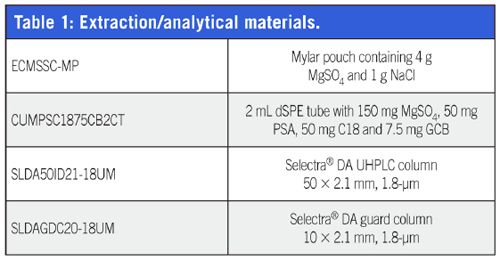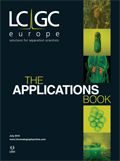Determination of Patulin in Processed Foods Using QuEChERS Extraction and UHPLC–MS–MS Analysis
The Application Notebook
Brian Kinsella, UCT, LLC
This application note outlines a QuEChERS procedure for the detection of patulin in processed food products. It typically grows on fruit, including apples, pears, peaches, and grapes, but has also been reported in vegetables and cereal grains. Patulin has been implicated as a possible carcinogen and teratogen, although an official designation has not yet been made. An apple-based baby food product was used as a representative sample matrix. The inclusion of graphitized carbon black (GCB) in the dispersive solid-phase extraction (dSPE) cleanup step produces a clean sample extract. Analysis is carried out by ultrahigh-pressure liquid chromatography coupled to tandem mass spectrometry (UHPLC–MS–MS) using the polyaromatic Selectra® DA column.

Procedure
1. Sample Extraction:
(a) Weigh 10 g of sample into a 50 mL polypropylene centrifuge tube.
(b) Add 10 mL of acetonitrile.
(c) Add the contents of the ECMSSC-MP Mylar pouch and shake for a minimum of 1 min (by hand or mechanically).
(d) Centrifuge the samples at ≥ 3000 × g for 5 min.
2. Sample Clean-up of Extract
(a) Transfer 1 mL of supernatant to a 2 mL dSPE tube (CUMPSC1875CB2CT).
(b) Vortex the sample for 30 s.
(c) Centrifuge the samples at ≥ 3000 × g for 5 min.
(d) Transfer 500–600 µL of purified supernatant into an autosampler vial (filter if desired).
Instrumental
LC–MS–MS: Thermo Scientific™ Dionex™ Ultimate™3000 UHPLC and TSQ Vantage™ (MS–MS)
Column: UCT Selectra® DA UHPLC column 50 × 2.1 mm, 1.8-μm
Guard column: UCT Selectra® DA guard column 10 × 2.1 mm, 1.8-μm
Injection volume: 5 μL
Mobile phase A: D.I. H2O
Mobile phase B: Acetonitrile
Column flow rate: 0.40 mL/min
Results

Conclusion
Excellent recoveries ranging from 83% to 90.1% were obtained using UCT’s QuEChERS salts (ECMSSC-MP) and dSPE (CUMPSC1875CB2CT) clean-up procedure in conjunction with the Selectra® DA HPLC column (SLDA50ID21-18UM) for the analysis of patulin in processed foods. For increased sensitivity, clean-up of a 5 mL extract using a 15 mL dSPE tube (ECQUEU615CT) can also be used.

UCT, LLC
2731 Bartram Road, Bristol, Pennsylvania 19007, USA
Tel: (800) 385 3153
E-mail: methods@unitedchem.com
Website: www.unitedchem.com

New Study Reviews Chromatography Methods for Flavonoid Analysis
April 21st 2025Flavonoids are widely used metabolites that carry out various functions in different industries, such as food and cosmetics. Detecting, separating, and quantifying them in fruit species can be a complicated process.
Analytical Challenges in Measuring Migration from Food Contact Materials
November 2nd 2015Food contact materials contain low molecular weight additives and processing aids which can migrate into foods leading to trace levels of contamination. Food safety is ensured through regulations, comprising compositional controls and migration limits, which present a significant analytical challenge to the food industry to ensure compliance and demonstrate due diligence. Of the various analytical approaches, LC-MS/MS has proved to be an essential tool in monitoring migration of target compounds into foods, and more sophisticated approaches such as LC-high resolution MS (Orbitrap) are being increasingly used for untargeted analysis to monitor non-intentionally added substances. This podcast will provide an overview to this area, illustrated with various applications showing current approaches being employed.

.png&w=3840&q=75)

.png&w=3840&q=75)



.png&w=3840&q=75)



.png&w=3840&q=75)









